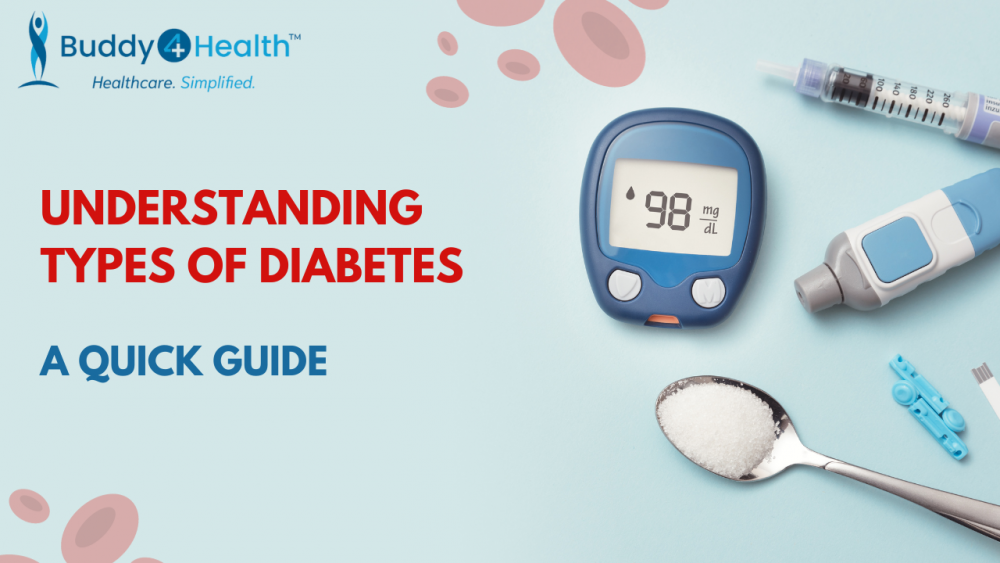

Diabetes is a chronic medical condition that affects millions of people worldwide. It is characterized by elevated blood sugar levels due to problems with insulin, a hormone produced by the pancreas that regulates blood glucose. To better understand diabetes, it's crucial to be aware of its different types, each with its unique features, causes and management strategies. In this guide, we will delve into the various types of diabetes, shedding light on the differences, risk factors, and treatment options.
Further, India is the 'diabetes capital of the world', according to a study by the Indian Council of Medical Research that shows the country now has 101 million diabetics, with a further 136 million pre-diabetic individuals in need of prevention.
Types of Diabetes
1. Type 1 Diabetes (T1D):
- Cause: Autoimmune response where the body's immune system attacks and destroys insulin-producing beta cells in the pancreas.
- Onset: Often diagnosed in childhood or adolescence.
- Treatment: Requires insulin injections or an insulin pump for life.
2. Type 2 Diabetes (T2D):
- Cause: Insulin resistance, where the body's cells do not respond effectively to insulin, and a relative lack of insulin production.
- Onset: Commonly develops in adulthood, but it can occur in youth.
- Treatment: Lifestyle modifications, oral medications, and in some cases, insulin therapy.
3. Gestational Diabetes:
- Cause: Develops during pregnancy when the body cannot produce enough insulin to meet increased needs.
- Onset: During pregnancy.
- Treatment: Dietary adjustments, exercise, and, in some cases, medication.
4. Monogenic Diabetes:
- Cause: Caused by specific gene mutations affecting insulin production or function.
- Onset: Can occur at any age.
- Treatment: Medications or insulin therapy, depending on the genetic mutation.
Risk Factors
Type 1 Diabetes:
- Family history of T1D.
- Presence of certain autoimmune conditions.
- Exposure to viral infections in early childhood.
Type 2 Diabetes:
- Obesity or overweight.
- Sedentary lifestyle.
- Family history of T2D.
- Age (risk increases with age).
- Overweight during pregnancy.
- Family history of diabetes.
- Previous gestational diabetes.
- Family history of monogenic diabetes.
- Specific genetic mutations.
While the symptoms can vary between the types, common diabetes symptoms include:
- Frequent urination.
- Excessive thirst.
- Unexplained weight loss.
- Fatigue.
- Blurred vision.
- Slow wound healing.
- Numbness or tingling in the extremities.
Diabetes is diagnosed through various tests, including:
- Fasting Blood Sugar Test: Measures blood sugar after an overnight fast.
- Oral Glucose Tolerance Test: Measures blood sugar levels after drinking a sugary solution.
- HbA1c Test: Provides a snapshot of blood sugar control over the past few months.
A healthy diet is crucial for managing diabetes. It is important to choose foods that are low in sugar and processed carbohydrates, and high in fiber and nutrients. Some good food choices for people with diabetes include:
- Fruits
- Vegetables
- Whole grains
- Lean protein
- Healthy fats
It is also important to limit your intake of saturated and unhealthy fats, cholesterol, and sodium.
Regular exercise is another important part of managing diabetes. Exercise helps to lower blood sugar levels and improve insulin sensitivity. Aim for at least 30 minutes of moderate-intensity exercise most days of the week. Some good exercise options for people with diabetes include:
- Walking
- Jogging
- Swimming
- Biking
- Dancing
A sedentary lifestyle is a major risk factor for developing diabetes. People who sit for long periods of time are more likely to develop type 2 diabetes. It is important to get up and move around regularly throughout the day.
Here are some tips for breaking up sedentary time:
- Take a walk after every meal
- Take the stairs instead of the elevator
- Park farther away from your destination
- Stand up and move around every 30 minutes
- Cutting on sugar
Sugar is a major contributor to weight gain and unhealthy blood sugar levels. People with diabetes should limit their intake of sugar as much as possible. Some good ways to cut down on sugar include:
- Drinking water or unsweetened tea or coffee instead of sugary drinks
- Eating fruits instead of desserts
- Choosing low-sugar snacks
- Reading food labels carefully and choosing products with low sugar content
It is important to see your doctor for regular checkups to monitor your diabetes and make sure you are on track. Your doctor will check your blood sugar levels, blood pressure, cholesterol, and other health markers. They will also work with you to develop a treatment plan that is right for you.
- Regular blood sugar monitoring.
- Insulin therapy.
- Balanced diet and regular exercise.
- Lifestyle changes (diet and exercise).
- Oral medications or insulin.
- Monitoring blood sugar levels.
- Dietary modifications.
- Regular physical activity.
- Medication if needed.
Monogenic Diabetes:
- Genetic testing to identify the specific mutation.
- Treatment tailored to the genetic cause.
Understanding the types of diabetes is crucial for effective management and prevention. While diabetes can be a challenging condition, advancements in treatment and a focus on a healthy lifestyle can help individuals lead fulfilling lives while managing the disease. If you suspect you have diabetes or are at risk, consult a healthcare professional for guidance and support.
Knowledge and awareness are powerful tools in the fight against diabetes, and on World Diabetes Day, it's essential to educate ourselves and others about this condition. This knowledge can make a difference in the lives of those affected by diabetes, offering hope and improved quality of life.

Low Blood Pressure: Understanding the Normal Range, Detection, and Natural Treatment at Home

Irritable Bowel Syndrome (IBS): What You Need to Know About Symptoms, Causes, and Treatment